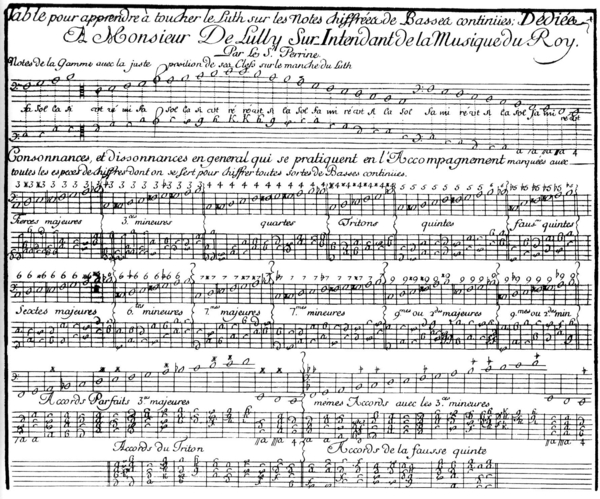Introduction
Lesson one: notes, intervals, scales and chords
Lesson two: exercises
Lesson three: basic rules
Lesson four: first practical steps
Lesson five: three songs by Telemann
Lesson two: exercises
I have taken two publications (1680 and 1698) by the French lutenist Perrine as a guideline for a few exercises to start you on your continuo career. Perrine’s instructions are both practical and historical. From studying them it is clear that playing continuo requires mental as well as physical training, so if your knowledge of music theory is insufficient, do return to the explanations in the previous lesson. You can also find many modern books and treatises on the subject. For now, it is enough to know about notes, intervals, scales and chords.

Part of the ‘Table for learning to play figured bass on the lute’ by Perrine (added to the 1698 edition of his Livre de Musique pour le Lut of 1680).1) You have to become familiar with staff notation. You can take any music, instrumental or vocal, and play the seperate staves, preferably transposing to the most suitable octave on your lute. If you have lute music in staff notation, so much the better, as you can read both staves together to play the whole piece. It is not important to learn to play the pieces, because the aim of the exercise is to familiarise yourself with staff notation.
2) You will need to feel at ease playing in all the keys. Play scales, major and minor in all common keys, or as many as you can handle, starting low, going up as high as you can, and try to find an alternative way back on the fingerboard. This way you will get to know all positions on all courses.
3) Play scales in intervals. Above the bass you can play a third, fourth, fifth, sixth, seventh, octave or ninth (or second, Perrine makes no distinction), major, minor, diminished, pure or augmented according to the key signature. Play the interval in a convenient octave. Do this in all common keys, or as many as you can handle. Here is an example of thirds above the bass, on a scale of C-major.
 4) Find chord shapes for all major and minor chords and try to see patterns in these shapes. For example, moveable major and minor chord shapes with the root on the sixth course:
4) Find chord shapes for all major and minor chords and try to see patterns in these shapes. For example, moveable major and minor chord shapes with the root on the sixth course:
 And moveable major and minor chord shapes with the root on the fifth course:
And moveable major and minor chord shapes with the root on the fifth course:
 And, finally, moveable major and minor chord shapes with the root on the fourth course:
And, finally, moveable major and minor chord shapes with the root on the fourth course:
 Other patterns are for example the relation between major and minor chord shapes, often just one finger difference. It makes sense to practice these chords also in scales going up and down. For example in the key of C-major, you can play a chord on each of the notes of the scale, major or minor according to the key signature. Perrine gives a minor chord on the seventh note in the scale, but you might want to play a diminished chord here.
Other patterns are for example the relation between major and minor chord shapes, often just one finger difference. It makes sense to practice these chords also in scales going up and down. For example in the key of C-major, you can play a chord on each of the notes of the scale, major or minor according to the key signature. Perrine gives a minor chord on the seventh note in the scale, but you might want to play a diminished chord here.
Here is one possible solution to playing chords above a scale in C-major:
 This is quite a lot for one lesson. Don’t try everything at once, but gradually build up your reading and playing skills. In the first week you could start with
This is quite a lot for one lesson. Don’t try everything at once, but gradually build up your reading and playing skills. In the first week you could start with
1) playing simple melodies in bass and treble clef,
2) play scales with no more than one flat or sharp,
3) play these scales in octaves and
4) find the shapes of the chords in the key of C-major.
The second week you might want to read a little more complicated music and try some more scales, intervals and chords.
In the next lesson I will give some basic rules, a few tips on how to make your continuo more beautiful and a few more exercises.
David van Ooijen 2009
This lesson is part of a series that first appeared in Nostalgia, the news letter of the Lute & Early Guitar Society of Japan.